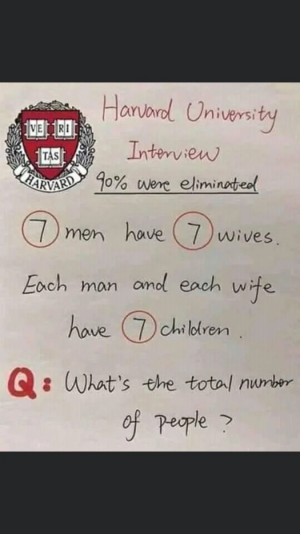Brain Teaser Only 10% Can Crack This Harvard-level Brainteaser—Do You Have What It Takes?
- Replies 46
Brainteasers have a way of captivating our minds, offering a mix of challenge and entertainment that can be both frustrating and satisfying. They're not just for passing the time; they're also a great way to keep our brains sharp, especially as we get older. And when it comes to brainteasers, there's a certain allure to those that are rumored to have stumped the best and brightest—like the one purportedly used in Harvard University interviews.
This particular puzzle has been making the rounds on social media, and it's said that a whopping 90% of people can't solve it. But before you start feeling discouraged, remember that puzzles like these are designed to make you think differently. They're not just about your IQ; they're about how you approach problems and whether you can think outside the box.

The brainteaser goes like this: 'If there are seven men with seven wives and each man and each wife have seven children, what is the total number of people?' At first glance, it seems like a straightforward math problem, but there's a twist—it has two possible answers.
The confusion arises from the wording of the question, which can be interpreted in different ways. Some people might read it as each man having one wife, which would lead to a total of 63 people—7 men, 7 wives, and their 49 children (7 children per couple). However, others might see it as each man having seven wives, which would significantly increase the number of people involved.
If you go down the path of each man having seven wives, the math works out like this: 7 men plus their 49 wives (7 wives for each of the 7 men) equals 56 adults. Then, if each wife has 7 children, that's 343 children (49 wives times 7 children each). Add the 56 adults to the 343 children, and you get a total of 399 people.
The debate over the correct answer has sparked a lot of discussion online, with people defending their interpretations and calculations. Some argue that the ambiguity is intentional, designed to see how candidates handle unclear instructions and whether they can justify their reasoning.
Mathematical brainteasers like this one are valuable because they force us to analyze information critically and consider multiple perspectives. They test our ability to break down complex problems into smaller, more manageable parts and to apply creative thinking when faced with ambiguity.
If you found yourself scratching your head over this puzzle, take comfort in knowing that you're in good company. Many people struggle with these types of questions, and it's not necessarily a reflection of your intelligence or capability. It's more about how you process information and whether you can adapt your thinking to new and unexpected challenges.
And while it's unclear whether this brainteaser actually originated from Harvard's interview process (DailyMail.com has reached out to the university for confirmation), it's certainly captured the imagination of puzzle enthusiasts around the world.
 So, dear readers, did you manage to solve the brainteaser? Which interpretation did you choose, and how did you arrive at your answer? Share your thoughts and solutions with us in the comments below. Whether you got it right or not, remember that the real joy of puzzles lies in the journey, not just the destination. Keep challenging yourself, and who knows? You might just outsmart the next brainteaser that comes your way.
So, dear readers, did you manage to solve the brainteaser? Which interpretation did you choose, and how did you arrive at your answer? Share your thoughts and solutions with us in the comments below. Whether you got it right or not, remember that the real joy of puzzles lies in the journey, not just the destination. Keep challenging yourself, and who knows? You might just outsmart the next brainteaser that comes your way.
This particular puzzle has been making the rounds on social media, and it's said that a whopping 90% of people can't solve it. But before you start feeling discouraged, remember that puzzles like these are designed to make you think differently. They're not just about your IQ; they're about how you approach problems and whether you can think outside the box.

An interview brainteaser reportedly from Harvard University stumps 90 per cent of people. Credit: Reddit / r/askmath
The brainteaser goes like this: 'If there are seven men with seven wives and each man and each wife have seven children, what is the total number of people?' At first glance, it seems like a straightforward math problem, but there's a twist—it has two possible answers.
The confusion arises from the wording of the question, which can be interpreted in different ways. Some people might read it as each man having one wife, which would lead to a total of 63 people—7 men, 7 wives, and their 49 children (7 children per couple). However, others might see it as each man having seven wives, which would significantly increase the number of people involved.
If you go down the path of each man having seven wives, the math works out like this: 7 men plus their 49 wives (7 wives for each of the 7 men) equals 56 adults. Then, if each wife has 7 children, that's 343 children (49 wives times 7 children each). Add the 56 adults to the 343 children, and you get a total of 399 people.
The debate over the correct answer has sparked a lot of discussion online, with people defending their interpretations and calculations. Some argue that the ambiguity is intentional, designed to see how candidates handle unclear instructions and whether they can justify their reasoning.
Mathematical brainteasers like this one are valuable because they force us to analyze information critically and consider multiple perspectives. They test our ability to break down complex problems into smaller, more manageable parts and to apply creative thinking when faced with ambiguity.
If you found yourself scratching your head over this puzzle, take comfort in knowing that you're in good company. Many people struggle with these types of questions, and it's not necessarily a reflection of your intelligence or capability. It's more about how you process information and whether you can adapt your thinking to new and unexpected challenges.
And while it's unclear whether this brainteaser actually originated from Harvard's interview process (DailyMail.com has reached out to the university for confirmation), it's certainly captured the imagination of puzzle enthusiasts around the world.
Key Takeaways
- A brainteaser reportedly used in Harvard University interviews has puzzled 90% of people attempting it.
- The question involves calculating the total number of people based on a scenario involving seven men, their wives, and children.
- The puzzle has multiple interpretations, leading to different answers ranging from 63 to 392 people.
- The brainteaser serves to highlight how individuals approach problem-solving and whether they are able to think outside the box.







